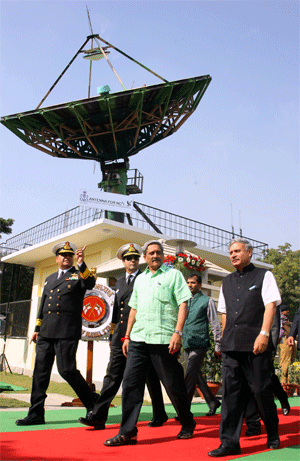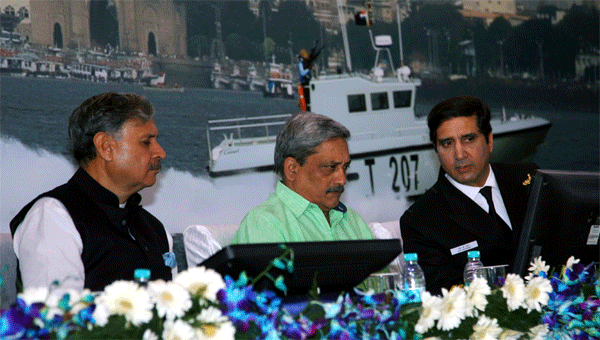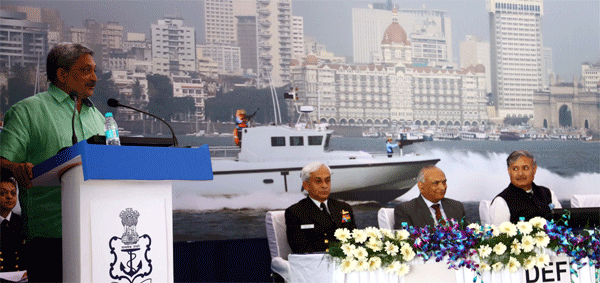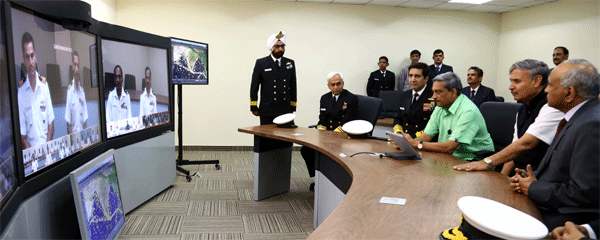| Unlike
the land borders and air space which are well defined, and where any incursion
is clearly taken as an intrusion, the seas are open for navigation, or Mare Liberum.
That allows hostile ships to come close to any country and no action is taken
unless they enter coastal waters. That is where the problem is, according
to Navy Chief Admiral RK Dhowan, and the situation is complicated as India itself
has some 240,000 fishing boats around its 7500 km long coastline. Any one of the
boats can be hijacked, as was done in the case of Kuber, and it would be extremely
difficult to know what happened till someone initiates hostile action. Nonetheless,
action is needed, and the Indian Navy has set up a network of sensors and optoelectronic
devices linking 51 stations, and all of them feed 24 x 7 the newly created Information
Management and Analysis Centre (IMAC), located in this multinational hub on the
outskirts of the Indian capital. The facility was inaugurated on November 23 by
the newly appointed Defence Minister, Mr Manohar Parikkar. 
The
Indian Navy and Indian Coast Guard (ICG) have the prime responsibility to safeguard
the seas around India. Technologically, the state-run Bharat Electroincs Limited
(BEL) has executed the project and its software backbone is supplied by US war
technology giant, Raytheon, duly acknowledged by the Navy at the ceremony. The
fact there were no intelligence inputs or warnings of the infiltration from the
seas, made Indians realize the importance of coastal security. In the aftermath,
several naval projects including acquisition of Boeing P8-I maritime surveillance
planes and the IMAC. The Navy also has its own satellite to ensure connectivity
with its assets on the high seas and the coastal belt. Significantly, while
the infiltrating terrorists had mobile phones with Indian and international connectivity
to communicate among themselves and to receive instructions from their handlers
in Pakistan, the Indians did not have this sensitivity. Indeed, US intelligence
agencies did monitor the terrorists’ chatter but chose not to inform India; this
came to be known after US authorities conducted investigations triggered by the
murder some of its own citizens in the mayhem. Today, a key element is the
involvement of fishermen. They are being trained to identify foreign elements.
And mobile phone connectivity is being ensured for them for reporting any suspicious
activity on toll free numbers. Biometric identification is being done to establish
the genuine Indian citizens. 26/11 was a wakeup call for the Navy, Coast
Guard, the nation’s homeland police and Intelligence bodies, and the top leadership.
IMAC is a big step towards removing the country’s sea blindness. The Navy
and Coast Guard are being expanded now. Marine police stations, offshore
patrol vessels, patrol boats, training and coordination with Customs, local police
units and fishermen, all ae being done on priority. New weapons are also being
supplied to the authorities to help neutralize a situation if something goes wrong.
Top level officers of various states are coordinating with the Navy, which is
the lead authority for India’s defence in the seas. 
Post
26/11. The Navy took immediate action towards creating a National Command Control
& Communications Intelligence network (NC3I). The most challenging task was to
set up a high bandwidth fusion centre where all inputs for coastal security from
towers with radars and cameras all along the coast and island territories and
fuse the data and inputs from all sources, including Intelligence, terrestrial
and space AIS so that warnings can be issued for preemptive and immediate reaction
as per set procedures and the challenge met. The Indian Navy had seen Singapore’s
Fusion Centre as a model. Singapore has very dense shipping in the Malacca Straits,
its lifeline. Critical software from Raytheon helped get the required solution,
and plans for India’s naval fusion centre called Information Management and Analysis
Centre (IMAC) began. The Government responded swiftly and NC3I was put
under the Cabinet Secretary with financial sanction of Rs 452 crores, and a National
Committee for Strengthening Maritime and Coastal Security (NCSMCS) was formed
under the Cabinet Secretary, the highest officer of the central Government, since
so many agencies were involved including top officers – Chief Secretaries – from
India’s constituent states. Land and resources are to be provided by them for
setting up the National Maritime Domain Awareness. at an estimated cost of Rs
1003 crores. This project is under active consideration of the Cabinet Committee
on Security (CCS). According to Rear Admiral KK Pandey, ACNS (Asstt. Chief
of Naval Staff) for Communications, Space and Net Centric Operations), civil works
for the IMAC facility commenced in October 2012. Transmission towers were set
up in a record time, and connectivity ensured with the Naval and Coast Guard headquarters
as well as with various regional bodies and remote points. He told India
Strategic on the occasion that the NC3I and IMAC will be linked to
the Navy's National Maritime Domain Awareness (NMDA) project. Joint Operations
Centres have been set up in Mumbai, Visakhapatnam, Kochi and Port Blair. 
Systems Integration by BEL In a crash project, the Coast
Guard selected equipment and sites were planned and a contract was awarded to
BEL to set up Terma, Xray and Seirra band radars, Observ cameras from Canada on
towers and lighthouses and to link 51 towers. More such towers are being set up
in Phase two with fibre, wireless and satellite connectivity. Transponders
from Swedish SAAB and some equipment from Dubai-based Indian owned Elcome have
also been used in the project. Security of data links is provided by DRDO. Civil
works on IMAC facility commenced in October 2012. Transmission towers sere set
up in record time, and connectivity was ensured with the Naval and ICG Headquarters
as well as various regional and remote centres. Inputs to IMAC ride on dedicated
terrestrial and satellite data circuits, and 24 x 7 connectivity has been ensured
with remote locations also. Navy has used advanced servers and devices from HP
and Cisco while the software from Raytheon was tweaked to Indian requirements
by BEL. The software provides automatic tracking of targets to get their
course and speed while the electro-optical devices have the capability to zoom
on any suspected boat. Long Range Information Tracking (LRIT) of ships is available.
Commercial satellites are also used and details from the Lloyds World Register
of Shipping (WRS) have been embedded to identify merchant and other vessels. All
the information is fused in computing clouds, and details can be pulled out instantly.
IMAC then is the hub with for enhanced awareness in a fused form for action.
Commanders can video conference in special cubicles to view the big and small
pictures. In future, the NC3I network and IMAC will be linked to the Navy’s
ambitious National Maritime Domain Awareness (NMDA) project. Notably, India
has invited 24 countries to join this venture for common good. Understandably,
the footprint of terrorism is widening and more the international cooperation,
the better it is. The Defence Minister congratulated the Navy and other
agencies involved in IMAC for its timely execution. Speaking on the occasion,
Admiral Dhowan stated that IMAC will go a long way in beefing up maritime surveillance,
thereby enhancing the National Maritime Domain Awareness Project. 
Minister
of State for Defence Rao Inderjit Singh, who hails from the Gurgaon region, Defence
Secretary RK Mathur and BEL Chairman cum Managing Director SK Sharma were among
those who attended the function. Representatives of various firms whose equipment
was used were also invited, and thanked. |